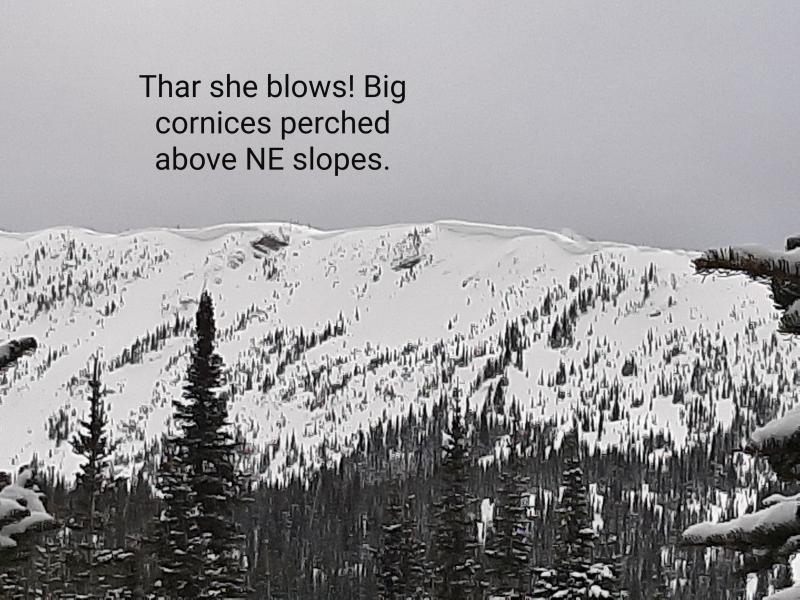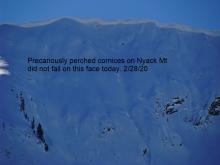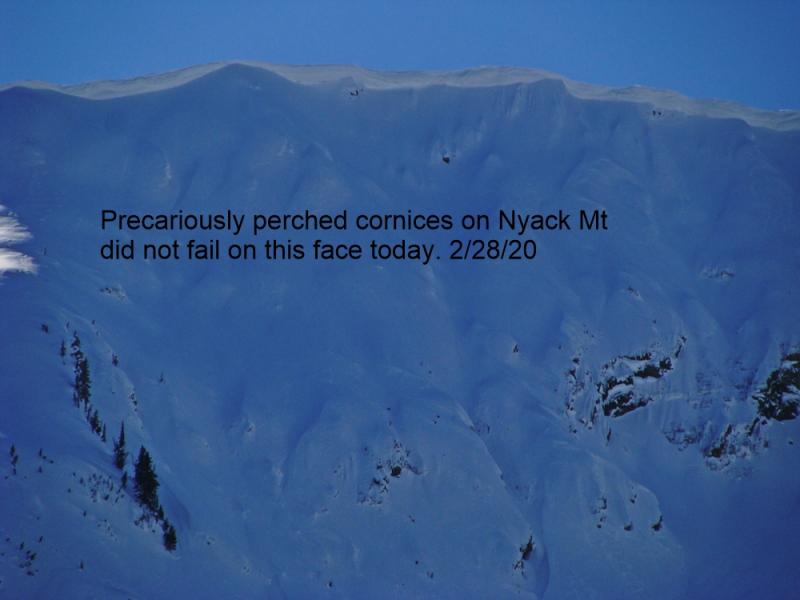| Sunday | Sunday Night | Monday | |
|---|---|---|---|
| Cloud Cover: | Dry conditions with breezy winds. | Cold temperatures with winds decreasing. | Mostly dry with cool temperatures. |
| Temperatures: | 28-43 deg. F. | 9-18 deg. F. | 28-41 deg. F. |
| Wind Direction: | West | West | East |
| Wind Speed: | 10-12 mph with gusts to 31 | 4-8 mph with gusts to 16 | 10-12 mph with gusts to 21 |
| Snowfall: | 0 in. | 0 in. | 0 in. |
| Snow Line: |
Whitefish Range
Swan Range
Flathead Range and Glacier National Park
How to read the forecast
Yesterday's substantial rainfall and warm temperatures resulted in an elevated avalanche danger today. The avalanche danger is MODERATE at all elevations due to a saturated snow surface at low and mid elevations and a weakening of cornices in the upper elevations. Pay attention to changing conditions at the snow surface and below the surface where free water is percolating through the snow pack.

2. Moderate
?
Above 6500 ft.
2. Moderate
?
5000-6500 ft.
2. Moderate
?
3500-5000 ft.
- 1. Low
- 2. Moderate
- 3. Considerable
- 4. High
- 5. Extreme
-
Type ?
-
Aspect/Elevation ?
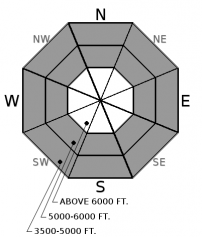
-
Likelihood ?CertainVery LikelyLikelyPossible
 Unlikely
Unlikely -
Size ?HistoricVery LargeLargeSmall

Yesterday's wild spring like weather deposited widely varying amounts of rainfall across our area. Some locations received minimal precipitation while other areas received over 1" of rain. The only common denominator is that this precipitation fell as rain at all elevations. Temperatures at upper elevations finally dropped below freezing late last night which, combined with moderate to strong winds, has "locked up" the surface snowpack at this elevation. Temperatures at low and mid elevations remain above freezing this morning where, due to the saturated snow surface, wet loose avalanches remain as a problem today. The snow surface has been "worked over" by recent warm wet weather so natural avalanche activity will be limited today but it will be possible to trigger a wet loose avalanche. Keep in mind that even short seemingly benign slopes can be dangerous when the effects of an avalanche are amplified by terrain traps like narrow gullies, cliffs, and trees.
-
Type ?
-
Aspect/Elevation ?
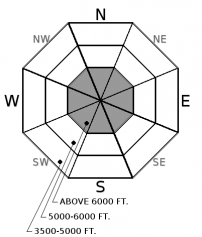
-
Likelihood ?CertainVery LikelyLikelyPossible
 Unlikely
Unlikely -
Size ?HistoricVery LargeLargeSmall

Substantial low density snowfall combined with windy conditions formed large cornices across our area this winter. These wind features had stayed in place for the majority of the winter until recent warm wet weather weakened them. BNSF Avalanche Safety observed cornice failures over the past week in John F. Stevens Canyon in southern Glacier Park and we assume cornice failure also occurred in other mountainous regions of our area. Yesterday's heavy rain in isolated locations, combined with warm temperatures, further weakened these features so it is best to stay well away from them while traveling along ridgelines. Falling cornices can trigger avalanches on the slopes beneath them so it is important to minimize exposure to slopes where cornices loom above.
Spring can bring a mixed bag of weather conditions to northwest Montana. It can surprise us with intense snow squalls, warm temperatures, and rain-on-snow events (even in the same day). This makes it increasingly important to closely monitor changing conditions. With longer days and a higher sun angle, conditions can rapidly change.
In isolated areas a layer of weak sugary snow (facets) sitting on top of the Feb. 10th rain crust produced unstable results in stability tests. I suspect that a few natural avalanches that occured recently were associated with that interface. This illustrates the importance of digging into the snow and continuing to assess deeper instabilities particularly after a recent, substantial load. In most locations the Feb. 10 crust is buried 2.5 to 4 feet from the snow surface.
Friday: Mark toured into Rescue Creek in the Flathead Range and observed substantial avalanche activity from the warm wet weather of 3/15. Avalanches were noted on all aspects at all elevations. Avalanche debris traveled the length of the valley floor with a destructive size of D4. A strong surface crust was present on the snow surface at all elevations. Guy rode in Hellroaring Creek in the Mission Mountains and found evidence of recent wet loose and slab avalanches. He also noted glide cracks and a stout surface crust.
Thursday: Adam and Todd were on Tunnel Ridge in the Flathead Range. Temperatures started off warm , but rapidly decreased as a cold front moved into the area. Up to about 6000 feet they found that recent melt and rain water had percolated through the entire snow pack. At 7000 feet only the upper snowpack was moist. Along the ridgeline wind direction was variable with gusts to 45 mph, but only transporting snow on the highest surrounding peaks. WMR Ski Patrol reported natural loose, wet activity in the Skook Chutes with debris all the way to Canyon Creek. They suspected these avalanches to have run on Wednesday (3/15).
Wednesday: BNSF avalanche safety reported natural avalanche activity in the John F. Stevens Canyon. These loose, wet and wet slab avalanches were estimated at size 2-3 and a few reached the valley floor.
See below for all observations this season.
Yesterday was a wild day of weather with variable conditions across our advisory area. Continuous extreme winds (>38 mph) were recorded at the Hornet weather station, in the northern Whitefish Range, for 3 consecutive hours (40, 44 and 48 mph) with maximum gusts during this time frame of 61, 67 and 69 mph! Rainfall amounts varied widely across our area with favored locations being the interior of Glacier Park where 1.6" fell at Flattop and the Java East weather station in John F. Stevens Canyon receiving 1.27". Currently, temperatures above 6000' range from 25-35º F with winds of 9-18 mph and gusts to 29. Much cooler temperatures are on tap for today with light to moderate winds and occasional strong gusts. Precipitation has ended and today through tonight will remain dry.
| 0600 temperature: | 25-35 deg. F. |
| Max. temperature in the last 24 hours: | 35-43 deg. F. |
| Average wind direction during the last 24 hours: | Southwest |
| Average wind speed during the last 24 hours: | 8-48 mph |
| Maximum wind gust in the last 24 hours: | 29-69 mph |
| New snowfall in the last 24 hours: | 0 inches |
| Total snow depth: | 87-118 inches |
This advisory applies only to backcountry areas outside established ski area boundaries. This advisory describes general avalanche conditions and local variations always occur. This advisory expires at midnight on the posted day unless otherwise noted. The information in this advisory is provided by the USDA Forest Service who is solely responsible for its content.













